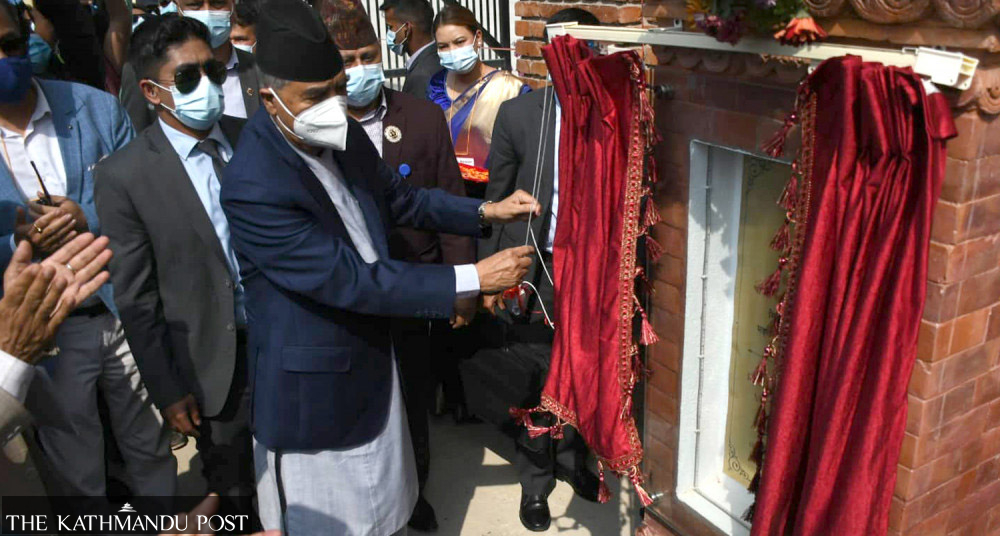Money
Chobhar dry port opens for business
Private sector representatives say dry port’s relevance will increase after Kathmandu-Tarai way is complete or a railroad arrives in Capital.
Krishana Prasain
Three cargo containers entered the newly built Chobhar dry port in Kirtipur on Tuesday marking the formal operation of the facility.
Prime Minister Sher Bahadur Deuba inaugurated the facility, which is located in the southwestern corner of Kathmandu Valley and occupies 11.77 hectares.
The dry port or Inland Clearance Depot will allow importers to make customs clearance of their goods in Kathmandu itself, saving them trips to the various border checkpoints from where shipments enter Nepal.
“This kind of infrastructure will help facilitate trade,” the prime minister said. “It is important to increase investment in infrastructure for economic growth.”
He said that the facility would ease imports and exports and make Nepal’s trade more managed and competitive.
Responding to stakeholders' suggestions to connect the dry port with railroad, Deuba said that railway is important but would require huge investments beyond Nepal’s capacity. “We can build railways only if somebody funds us or provides subsidised loans,” he said.

The then Prime Minister KP Sharma Oli, on January 18, 2019, had laid the foundation for the dry port. The construction of the infrastructure was completed in mid-June last year.
According to customs officials, the facility had been completed eight months ago, but the inauguration was delayed as it was necessary to complete internal work and enact laws to operate the facility.
The dry port was constructed at the cost of Rs1.54 billion, a loan from the World Bank.
A 35,000 square feet parking area has been constructed for a total of 500 containers and 500 trucks. The dry port has three buildings that will have customs, quarantine facility, security, three warehouses, stuffing and stuffing shed [storage], three weighing machines, an electric sub-station and boundary lights.
Vishnu Agrawal, the president of the Confederation of Nepalese Industries, speaking on the occasion, said that the construction of the dry port would minimize the cost of logistics, time and problems related to the import and export of goods.
“Domestic manufacturers are expecting that the dry port will help minimize the cost of production and cost of export but if that does not happen then the construction of this huge infrastructure will be useless,” Agrawal said.
Agrawal said the private sector is expecting that traders will be able to import goods directly from Kolkata or Visakhapatnam ports without any problem to Chobhar dry port.
“We expect the same for exports as well,” he said.
“Chobhar dry port’s relevance will increase further once the Kathmandu-Tarai expressway project comes into implementation or a railroad arrives to Kathmandu,” Agrawal said.

Chobhar dry port is divided into two sections—export-import and domestic. The export-import section can accommodate 116 20-foot equivalent units (TEU), an inexact unit of cargo capacity often used for container ships.
Shekhar Golchha, the president of the Federation of Nepalese Chambers of Commerce and Industry, said that Chobhar dry port will be highly useful especially to small and medium-scale entrepreneurs centered in Kathmandu and those who want to export their goods.
“The cost of production of domestically-produced goods and services are high mainly due to weak trading infrastructure and high costs of importing raw materials,” Golchha said. “We hope that Chobhar dry port will minimize the cost of imports,” he said.
“Currently around 40 percent of the country’s total diesel imports is used for transporting goods to Kathmandu, so if we connect the Chobhar dry port with an electric railway in future, since we will have excess electricity, then traders will use the dry port even more,” Golchha said.
Meanwhile, Ramesh Maharjan, the mayor of Kirtipur Municipality, complained the government has yet to fully compensate the people for the land acquired for the dry port. The government had acquired 216 ropani but has yet to pay compensation for 100 ropanis, according to Maharjan. “The land for which compensation has not been paid should be returned to the owners,” he demanded.
He also said that employees of the Himal Cements Factory, at whose site the dry port is located, have not been paid their salaries totalling around Rs100 million. “Although we had demanded with the government to clear the employees’ dues before starting the dry port construction, that did not happen,” Maharjan said, adding, “The prime minister should heed the demand without delay.”
Local stakeholders have also demanded that the government upgrade the road linking the dry port with Thankot as the existing road cannot sustain the huge volume of cargo traffic involving 40 and 20 feet containers and cause traffic jams.
“As import and export of goods is becoming more time consuming and costlier, we expect that the dry port will play a crucial role in easing internal and international trade,” said Ashish Gajurel, executive director of the Nepal Intermodal Transport Development Board.
The inland facility providing storage and customs clearance services is not an entirely new concept in Kathmandu. Even during the Rana period, there was Teku Bhansar where cargo arrived from Bhimphedi on the backs of porters or by ropeway and was customs-cleared.
The Nepal Intermodal Transport Development Board, the government agency responsible for the construction and operation of the dry port, said that after a certain period, the new facility would be handed over to the private sector through a competitive bidding process.
As 60-70 percent of all imported goods are consumed in the valley, it will be a big respite for traders importing goods for sale in Kathmandu.
In the last fiscal year 2020-21, Nepal’s foreign trade was valued at Rs1.68 trillion.




 17.12°C Kathmandu
17.12°C Kathmandu















